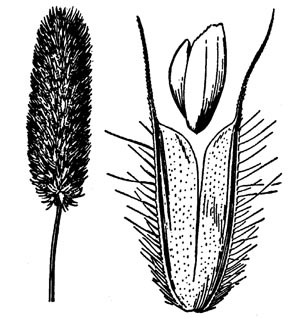Alpine Timothy

Common Name(s):
Alpine Timothy
Mountain Timothy
Scientific Name:
Phleum alpinum L.
Scientific Name Synonyms:
Phleum commutatum Gaudin
another synonym goes here
Symbol:
PHAL2
Description:
Life Span: Perennial
Origin: Native
Season: Cool
Growth Characteristics: Alpine Timothy is a short, somewhat sod-forming perennial bunchgrass. The stems are solitary to slightly grouped, erect to somewhat bending (decumbent) at base, 6-24 inches tall, hollow, smooth, hairless. The base of the plant lacks the bulb-like structure found in Common Timothy (Phleum pratense). It reproduces from seed and tillers. Roots are fibrous. It flowers June through August.
Seedhead: The seedhead is oval to tubular in shape. It is actually a dense panicle, twisted around the axis of the seedhead. The panicle is ½ to 2 inches long, ranging from 1 ½ to 3 times as long as wide and purplish in color. The spikelets are flattened and 1-flowered; glumes are long, thin, with hairy-fringe on one side; awns up to 1/8 inch long. Awned heads give alpine timothy a bristle appearance.
Leaves: Blades are flat or loosely rolled; smooth to hairy on top, commonly 1/16 inch wide, tapering to the tip. They are 2 ½ - 6 inches long; sheaths are open and hairless; ligules short, collar shaped, membranous; auricles small to absent.
Growth Characteristics:
growth characteristics go here
Ecological Adaptions:
Alpine Timothy occurs in higher elevations and higher latitudes worldwide. It is a cold tolerant grass, and is found in mesic to wet alpine or subalpine meadows, grassy slopes, marshes, and along stream banks, at elevations ranging from 4000 to 12500 feet. It naturally revegetates somewhat in open or disturbed sites in western mountains.
Soils: Well drained to very wet soils.
Associated Species: Aspen, American bistort, sedges, rushes, willows, tufted hairgrass, and redtop. Also associated with moist sagebrush sites.
Uses and Management:
The forage value of alpine timothy is good, being palatable to all domestic livestock as well as to deer and elk. It has survived in many areas despite heavy spring grazing but produces much more herbage where it is moderately grazed and given occasional rest from heavy use. It produces good forage that remains green throughout the summer and valuable as a late season feed.
It is often used in seeding mixtures to revegetate disturbed areas such as roads, ski slopes, and mined lands.

